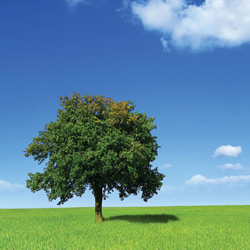
I saw a sign the other day that said, “God wouldn’t give us winter without the promise of spring.” As a landscape architect, spring is one of my favorite seasons of the year, and as Mother Nature slowly starts to release her grip on winter, I can’t help but become excited about the prospect of work we have designed over the last few months that will become a reality this season.
Today, we are faced with the new challenge of being “green.” But what does that really mean in the landscape industry? One could make the argument that simply installing some landscape is truly a green endeavor. Who could argue with that? Plants are living, breathing organisms that take harmful elements from our environment, store them within their systems, and then provide us with clean, breathable air and beautiful displays of foliage and color. All they ask for in return is water, some decent soil, and occasional feeding and pruning. But are these truly “green” landscapes?
As we strive to become more “green,” several tools and products are available to the landscape industry that help us to make informed, relevant decisions for creating beautiful environments while conserving natural resources. Here are just a few examples of products that landscape architects have available to them to design beautiful grounds while saving money and resources.
Lawns. Today you have a choice between traditional Kentucky bluegrass, perennial ryegrass and fine fescue lawns. Each year, new and exciting varieties of these grasses are introduced that strive to provide those dark green and lush yards we desire while requiring less water and nutrients. Through massive studies and breeding programs, we can now blend various varieties of these grasses to suit the needs of your site. The decision of which specific mixture to use should be based on site conditions, its proposed uses and the ability to irrigate the grass. Don’t just settle for an off-the-shelf mix without considering your needs.
Trees. We have long known that native trees use less water, adapt better, and are healthier overall in our environment. The problem was that many of them were very difficult to propagate and grow successfully. Nurseries now have root control bags and air pruning systems that allow even some of the most difficult oaks to be grown in nursery conditions and made available in the marketplace. While this technology is still young, we have seen an ever-growing variety of native trees available that was unheard of even five years ago. Databases through the University of Illinois Extension Office, the Morton Arboretum and the Chicago Botanical Garden give us access to even greater amounts of information about the conditions needed for these trees to grow and succeed.
Irrigation Systems. Some of the biggest strides in the landscape industry have come in irrigation systems. Being “green” doesn’t necessarily mean elimination of irrigation. LEED projects allow credits for landscapes that are 50 percent more efficient in their use of irrigation water. This savings is usually accomplished in designing the proper plant for the space, as well as using new and improved irrigation equipment. Many of the irrigation heads used today have actually reduced the amount of water they use while increasing their overall efficiency. For even bigger water savings, consider installing drip irrigation for certain applications. While once only considered for desert area use, subsurface drip irrigation systems are available to enhance tree, shrub and ground cover plantings while only using a fraction of the water needed with an overhead spray system. Moisture sensors, smart controllers, pressure regulators and improved pumping systems all add to better water delivery systems while saving power and water.
There have also been great improvements in pavements, outdoor lighting, recycled furniture, fertilizers and even the installation methods of plants. So it’s time to get ready for spring and put all those resources to work in your outdoor spaces. Don’t sit back and do nothing. Embrace the new technology, enjoy your yards, and know you are doing your part to be “green.” iBi

